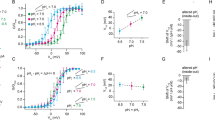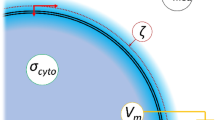Abstract
Electron transport across biological membranes is a well-known feature of bacteria, mitochondria and chloroplasts, where it provides motive forces for vectorial transport processes1. In contrast, electron transport is generally not found in the plasma membrane of eukaryotic cells, possibly because it would interfere with electric processes at the plasma membrane. An exception is provided by the phagocyte NADPH oxidase, which generates superoxide (

) through electron transfer from cytosolic NADPH to extracellular oxygen2,3,4,5. The enzyme is essential for host defence, and patients with chronic granulomatous disease, who lack the functional enzyme, suffer from severe infections6,7. It has been suggested that electron transfer by the NADPH oxidase might be electrogenic8. Here we demonstrate, using the whole-cell patch-clamp technique, the generation of electron currents by the NADPH oxidase in human eosinophil granulocytes. The currents were absent in granulocytes of sufferers of chronic granulomatous disease and under conditions of low oxygen. Generation of electron currents across the plasma membrane of eukaryotic cells has not been observed previously and might be — independently of the generation of superoxide — a physiologically relevant function of the phagocyte NADPH oxidase.
This is a preview of subscription content, access via your institution
Access options
Subscribe to this journal
Receive 51 print issues and online access
$199.00 per year
only $3.90 per issue
Buy this article
- Purchase on Springer Link
- Instant access to full article PDF
Prices may be subject to local taxes which are calculated during checkout




Similar content being viewed by others
References
Mitchell, P. Foundations of vectorial metabolism and osmochemistry. Biosci. Rep. 11, 297–346 (1991).
Klebanoff, S. J. Oxygen metabolism and the toxic properties of phagocytes. Ann. Intern. Med. 93, 480–489 (1980).
Clark, R. A. The human neutrophil respiratory burst oxidase. J. Infect. Dis. 161, 1140–1147 (1990).
Segal, A. W. & Abo, A. The biochemical basis of the NADPH oxidase of phagocytes. Trends Biochem. Sci. 18, 43–47 (1993).
Chanock, S. J., el Benna, J., Smith, R. M. & Babior, B. M. The respiratory burst oxidase. J. Biol. Chem. 269, 24519–24522 (1994).
Clark, R. A. Genetic variation in chronic granulomatous disease. Hosp. Pract. 25, 51–55 (1990).
Boxer, L. A. & Blackwood, R. A. Leukocyte disorders: quantitative and qualitative disorders of the neutrophil, part 1. Pediatr. Rev. 17, 19–28 (1996).
Henderson, L. M., Chappell, J. B. & Jones, O. T. The superoxide-generating NADPH oxidase of human neutrophils is electrogenic and associated with a H+ channel. Biochem. J. 246, 325–329 (1987).
Shult, P. A., Graziano, F. M., Wallow, I. H. & Busse, W. W. Comparison of superoxide generation and luminol-dependent chemiluminescence with eosinophils and neutrophils from normal individuals. J. Lab. Clin. Med. 106, 638–645 (1985).
Gallin, E. K. & McKinney, L. C. in Current Topics in Membranes and Transport. Vol. 35: Mechanisms of Leukocyte Activation (eds Kleinzeller, A., Grinstein, S. & Rotstein, O. D.) 127–152 (Academic, San Diego, 1990).
Nanda, A. & Grinstein, S. The membrane potential of resting and activated neutrophils: determinants and significance. Cell Physiol. Biochem. 1, 65–75 (1991).
Demaurex, N., Schrenzel, J., Jaconi, M. E., Lew, D. P. & Krause, K.-H. Proton channels, plasma membrane potential, and respiratory burst in human neutrophils. Eur. J. Haematol. 51, 309–312 (1993).
Newburger, P. E. et al. Parental diagnosis of chronic granulomatous disease. N. Engl. J. Med. 300, 178–181 (1979).
Cross, A. R. & Jones, O. T. The effect of the inhibitor diphenylene iodonium on the superoxide-generating system of neutrophils. Specific labelling of a component polypeptide of the oxidase. Biochem. J. 237, 111–116 (1986).
Schrenzel, J., Lew, D. P. & Krause, K. H. Proton currents in human eosinophils. Am. J. Physiol. Cell Physiol. 271, C1861–C1871 (1996).
Vives Corrons, J. L. et al. Severe-glucose-6-phosphate dehydrogenase (G6PD) deficiency associated with chronic hemolytic anemia, granulocyte dysfunction, and increased susceptibility to infections: description of a new molecular variant (G6PD Barcelona). Blood 59, 428–434 (1982).
Benesch, R. E. & Benesch, R. Enzymatic removal of oxygen for polarography and related methods. Science 118, 447–448 (1953).
Hille, B. Ionic Channels of Excitable Membranes (Sinauer Associates, Sunderland, MA, 1992).
Gordienko, D. V. et al. Voltage-activated proton current in eosinophils from human blood. J. Physiol. 496, 299–316 (1996).
Cherny, V. V., Markin, V. S. & De Coursey, T. E. The voltage-activated hydrogen ion conductance in a rat alveolar epithelial cells is determined by the pH gradient. J. Gen. Physiol. 105, 861–896 (1995).
Saier, M. H. Peter Mitchell and his chemiosmotic theories. ASM News 63, 13–21 (1997).
Zimmerli, W., Lew, D. P., Suter, S., Wyss, M. & Waldvogel, F. A. In vitro efficacy of several antibiotics against intracellular S. aureus in chronic granulomatous disease. Helv. Paediatr. Acta 38, 51–61 (1983).
Varnai, P. et al. Highly cooperative Ca2+ activation of intermediate conductance K+ channels in HL-60 granulocytes. J. Physiol. (Lond.) 472, 373–390 (1993).
Demaurex, N. et al. Regulation Ca2+ influx in myeloid cells: role of plasma membrane potential, inositol phosphates, cytosolic free [Ca2+], and filling state of intracellular Ca2+ stores. J. Clin. Invest. 90, 830–839 (1992).
Acknowledgements
We thank E. Huggler for technical assistance; L. Bernheim, S. Rawlings, and M. Rossier for discussions; W. Zimmerli, R. Seger and P. Beris for help with the patients; and N. Mensi for the G6PD determination. This work was supported by grants from the Swiss National Foundation (to J.S., K.-H.K., N.D., B.B.), the Janggen Poehn Foundation (J.S.), the Max Cloetta Foundation (N.D.), FEBS (B.B.), and the Swedish Medical Research Grant (L.S.).
Author information
Authors and Affiliations
Corresponding author
Rights and permissions
About this article
Cite this article
Schrenzel, J., Serrander, L., Bánfi, B. et al. Electron currents generated by the human phagocyte NADPH oxidase. Nature 392, 734–737 (1998). https://doi.org/10.1038/33725
Received:
Accepted:
Issue Date:
DOI: https://doi.org/10.1038/33725
This article is cited by
-
Nox4 expression in osteo-progenitors controls bone development in mice during early life
Communications Biology (2022)
-
The voltage-gated proton channel Hv1 promotes microglia-astrocyte communication and neuropathic pain after peripheral nerve injury
Molecular Brain (2021)
-
The function of TRP channels in neutrophil granulocytes
Pflügers Archiv - European Journal of Physiology (2018)
-
Nicotine inhibits activation of microglial proton currents via interactions with α7 acetylcholine receptors
The Journal of Physiological Sciences (2017)
-
Oleic acid promotes adaptability against oxidative stress in 3T3-L1 cells through lipohormesis
Molecular and Cellular Biochemistry (2014)
Comments
By submitting a comment you agree to abide by our Terms and Community Guidelines. If you find something abusive or that does not comply with our terms or guidelines please flag it as inappropriate.



